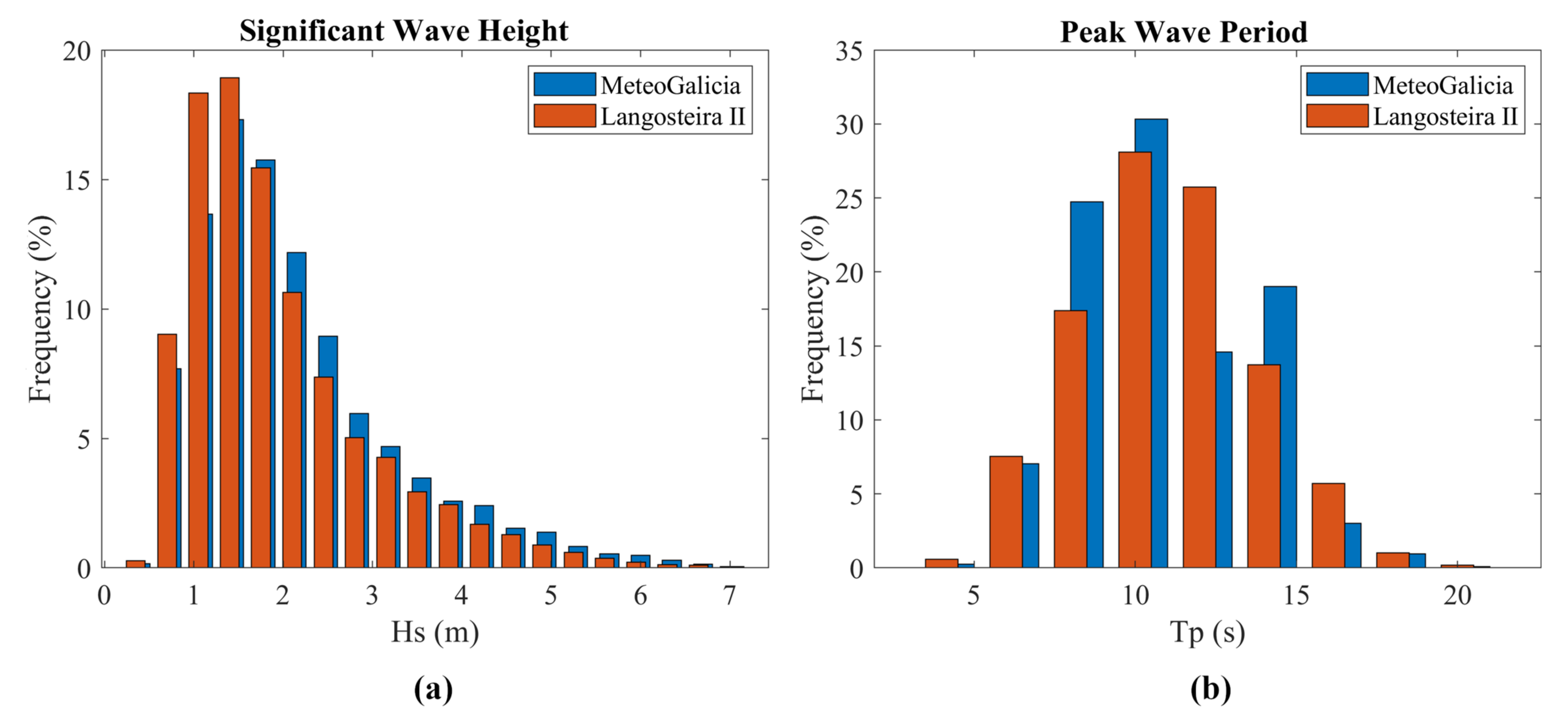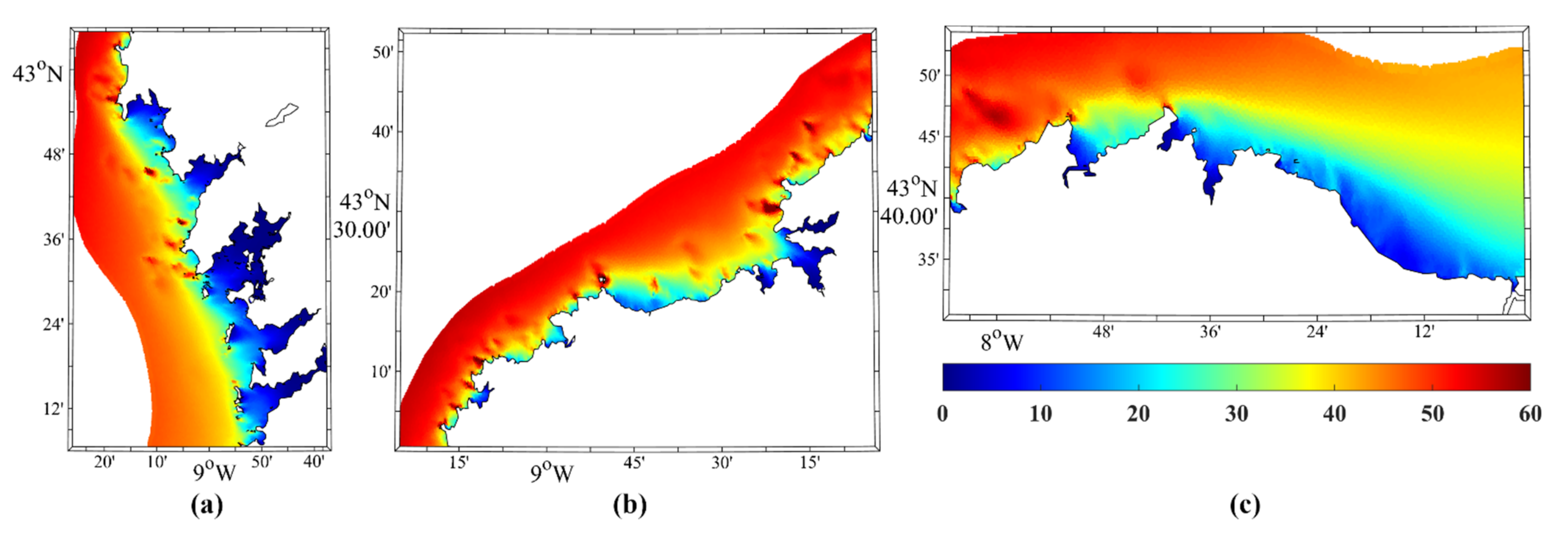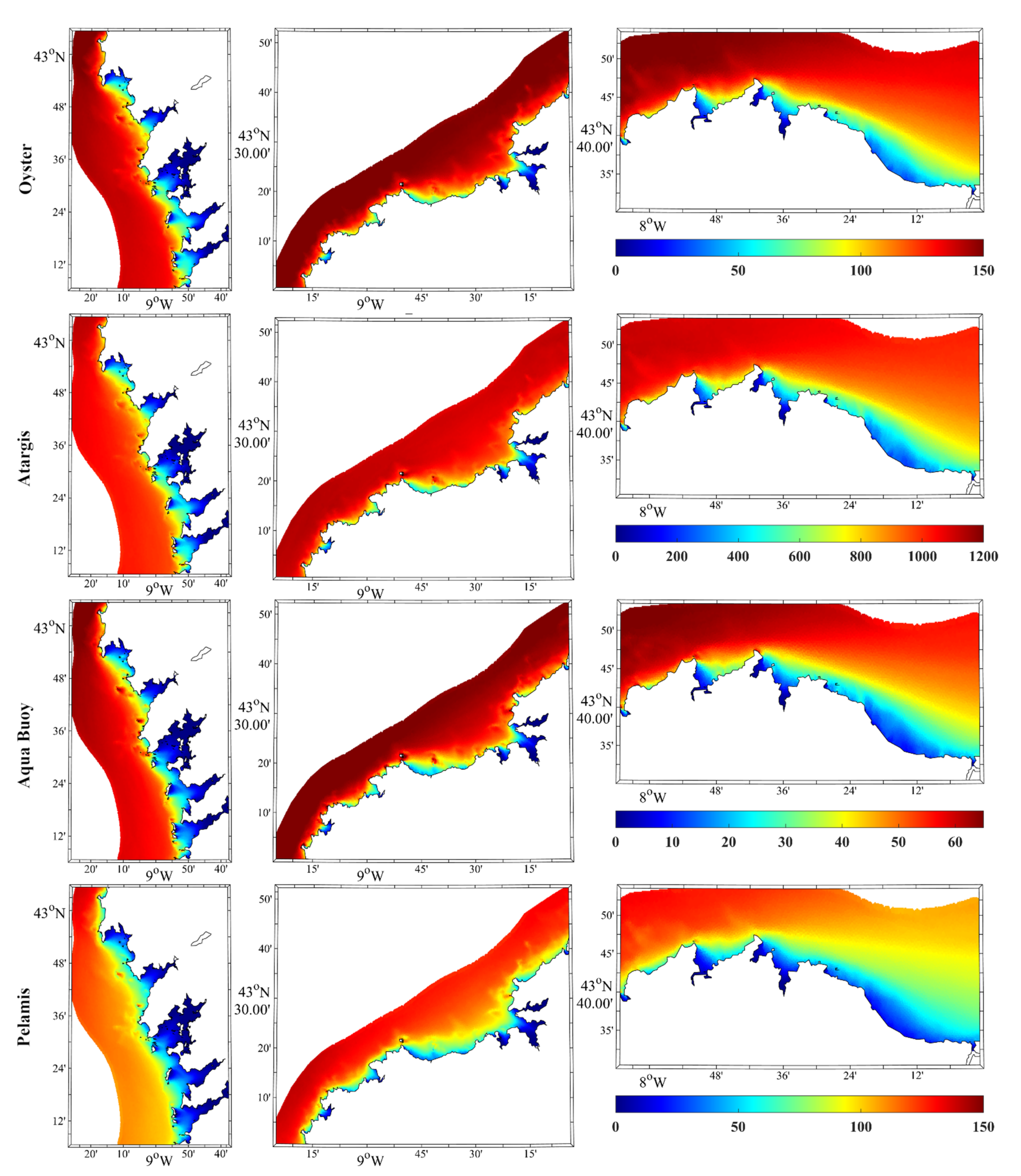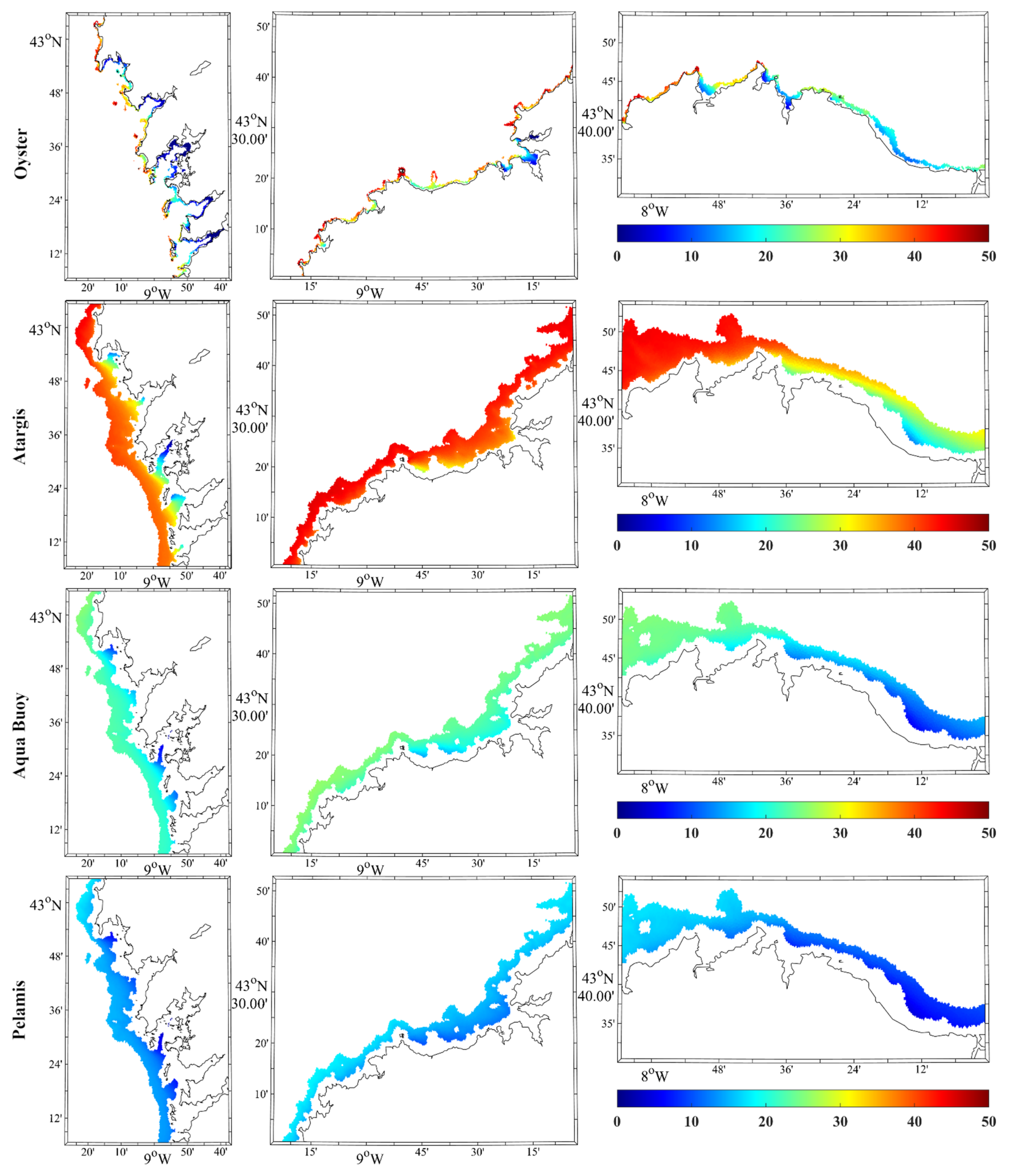Harnessing of Different WECs to Harvest Wave Energy along the Galician Coast (NW Spain)
Abstract
:1. Introduction and Studied Area
2. Data and Methodology
2.1. Data
2.2. Methodology
2.2.1. Validation
2.2.2. Wave Power Resource
2.2.3. Parameters to Analyze WEC Performance
3. Results
3.1. Numerical Model Validation
3.2. Wave Power Resource
3.3. Performance of WECs
4. Discussion
5. Conclusions
- –
- The wave power resource, the expected electrical energy output, and the power load factor decrease landward, while the efficiency increases landward.
- –
- The highest wave power resource is found in the northernmost part of the West Coast, the Northwest Coast, and the westernmost part of the North Coast.
- –
- Atargis is the device that shows the highest expected electrical energy output, followed by Oyster. Aqua Buoy is the device with the lowest electrical energy output.
- –
- Attending to the power load factor, Atargis is the best-availed device, followed by Oyster. Pelamis has obtained the lowest performance in the three regions.
- –
- The parameter efficiency could substitute capture width in future studies in order to estimate the WEC performance because it allows making comparisons between different WECs regarding their dimensions.
- –
- Looking at the efficiency, Atargis is definitely the most efficient device, while Oyster and Aqua Buoy are quite efficient in harvesting the wave power resource in the three regions. Pelamis has shown a low efficiency in the whole area.
- –
- Atargis seems to be the best device to be installed in the Galician coast—especially in the Northwest Coast region—due to its expected electrical output, performance, its location under the surface, and optimum depth, avoiding areas of environmental interest.
Author Contributions
Funding
Institutional Review Board Statement
Informed Consent Statement
Data Availability Statement
Acknowledgments
Conflicts of Interest
References
- IEA. World Energy Balances: Overview. Available online: https://www.iea.org/reports/world-energy-balances-overview (accessed on 22 January 2022).
- Masson-Delmotte, V.; Zhai, P.; Pirani, A.; Connors, S.L.; Péan, C.; Berger, S.; Caud, N.; Chen, Y.; Goldfarb, L.; Gomis, M.I.; et al. Climate Change 2021: The Physical Science Basis. Contribution of Working Group I to the Sixth Assessment Report of the Intergovernmental Panel on Climate Change; Cambridge University Press: Cambridge, UK; IPCC: New York, NY, USA, 2021. [Google Scholar] [CrossRef]
- Oliveira-Pinto, S.; Stokkermans, J. Assessment of the Potential of Different Floating Solar Technologies—Overview and Analysis of Different Case Studies. Energy Convers. Manag. 2020, 211, 112747. [Google Scholar] [CrossRef]
- Ritchie, H.; Roser, M. Fossil Fuels. Available online: https://ourworldindata.org/fossil-fuels?country= (accessed on 22 January 2022).
- Iberdrola. COP26: Iberdrola En La Cumbre Del Clima 2021. Available online: https://www.iberdrola.com/sostenibilidad/contra-cambio-climatico/cop26 (accessed on 22 January 2022).
- General Assembly. Resolution Adopted by the General Assembly on 6 July 2017; United Nations, A/RES/71/313. 2017. Available online: https://ggim.un.org/documents/a_res_71_313.pdf (accessed on 22 January 2022).
- Ribeiro, A.S.; deCastro, M.; Rusu, L.; Bernardino, M.; Dias, J.M.; Gomez-Gesteira, M. Evaluating the Future Efficiency of Wave Energy Converters along the NW Coast of the Iberian Peninsula. Energies 2020, 13, 3563. [Google Scholar] [CrossRef]
- Lavidas, G.; Blok, K. Shifting Wave Energy Perceptions: The Case for Wave Energy Converter (WEC) Feasibility at Milder Resources. Renew. Energy 2021, 170, 1143–1155. [Google Scholar] [CrossRef]
- IRENA. Offshore Renewables: An Action Agenda for Deployment; International Renewable Energy Agency: Abu Dhabi, United Arab Emirates, 2021; ISBN 978-92-9260-349-6. Available online: https://www.irena.org/-/media/Files/IRENA/Agency/Publication/2021/Jul/IRENA_G20_Offshore_renewables_2021.pdf (accessed on 22 January 2022).
- Rusu, E. Evaluation of the Wave Energy Conversion Efficiency in Various Coastal Environments. Energies 2014, 7, 4002–4018. [Google Scholar] [CrossRef] [Green Version]
- Aderinto, T.; Li, H. Review on Power Performance and Efficiency of Wave Energy Converters. Energies 2019, 12, 4329. [Google Scholar] [CrossRef] [Green Version]
- Mota, P.; Pinto, J. Wave Energy Potential along the Western Portuguese Coast. Renew. Energy 2014, 71, 8–17. [Google Scholar] [CrossRef]
- Kim, S.-J.; Koo, W.; Kim, M.-H. The Effects of Geometrical Buoy Shape with Nonlinear Froude-Krylov Force on a Heaving Buoy Point Absorber. Int. J. Nav. Archit. Ocean Eng. 2021, 13, 86–101. [Google Scholar] [CrossRef]
- Wang, L.; Zhao, T.; Lin, M.; Li, H. Towards Realistic Power Performance and Techno-Economic Performance of Wave Power Farms: The Impact of Control Strategies and Wave Climates. Ocean Eng. 2022, 248, 110754. [Google Scholar] [CrossRef]
- Ciappi, L.; Cheli, L.; Simonetti, I.; Bianchini, A.; Talluri, L.; Cappietti, L.; Manfrida, G. Wave-to-Wire Models of Wells and Impulse Turbines for Oscillating Water Column Wave Energy Converters Operating in the Mediterranean Sea. Energy 2022, 238, 121585. [Google Scholar] [CrossRef]
- Wang, L.; Ringwood, J.V. Control-Informed Ballast and Geometric Optimisation of a Three-Body Hinge-Barge Wave Energy Converter Using Two-Layer Optimisation. Renew. Energy 2021, 171, 1159–1170. [Google Scholar] [CrossRef]
- Mohtat, A.; Yim, S.; Osborne, A. Energy Content Characterization of Water Waves Using Linear and Nonlinear Spectral Analysis. J. Offshore Mech. Arct. Eng. 2022, 144, 011203. [Google Scholar] [CrossRef]
- Zhang, Y.; Zhao, Y.; Sun, W.; Li, J. Ocean Wave Energy Converters: Technical Principle, Device Realization, and Performance Evaluation. Renew. Sustain. Energy Rev. 2021, 141, 110764. [Google Scholar] [CrossRef]
- Lehmann, M.; Karimpour, F.; Goudey, C.A.; Jacobson, P.T.; Alam, M.-R. Ocean Wave Energy in the United States: Current Status and Future Perspectives. Renew. Sustain. Energy Rev. 2017, 74, 1300–1313. [Google Scholar] [CrossRef]
- Mofor, L.; Goldsmith, J.; Jones, F. Ocean Energy: Technology Readiness, Patents, Deployment Status and Outlook. Abu Dhabi 2014, 27. Available online: https://www.irena.org/publications/2014/Aug/Ocean-Energy-Technologies-Patents-Deployment-Status-and-Outlook (accessed on 22 January 2022).
- Pecher, A.; Kofoed, J.P. Handbook of Ocean Wave Energy; Springer Nature: Berlin, Germany, 2017. [Google Scholar]
- Olmo, B. Explotación Del Potencial de Energía Del Oleaje En Función Del Rango de Trabajo de Prototipos Captadores; Universitat Politècnica de Catalunya: Barcelona, Spain, 2009; Available online: https://upcommons.upc.edu/handle/2099.1/8720 (accessed on 22 January 2022).
- Rusu, L.; Onea, F. The Performance of Some State-of-the-Art Wave Energy Converters in Locations with the Worldwide Highest Wave Power. Renew. Sustain. Energy Rev. 2017, 75, 1348–1362. [Google Scholar] [CrossRef]
- Bozzi, S.; Archetti, R.; Passoni, G. Wave Electricity Production in Italian Offshore: A Preliminary Investigation. Renew. Energy 2014, 62, 407–416. [Google Scholar] [CrossRef]
- La Camera, F. IRENA Chief: Europe Is ‘the Frontrunner’ on Tidal and Wave Energy. 2020. Available online: https://www.euractiv.com/section/energy/interview/irena-chief-europe-is-the-frontrunner-on-tidal-and-wave-energy/ (accessed on 22 January 2022).
- IDAE. Eólica Marina y Energías Del Mar En España. Available online: https://www.idae.es/tecnologias/energias-renovables/uso-electrico/eolica/eolica-marina/eolica-marina-y-energias-del-mar (accessed on 22 January 2022).
- MITECO. Hoja de Ruta Para El Desarrollo de La Eólica Marina y de Las Energías del Mar en España; MITECO: Madrid, Spain, 2021; Available online: https://www.miteco.gob.es/es/ministerio/planes-estrategias/desarrollo-eolica-marina-energias/eshreolicamarina-pdfaccesiblev5_tcm30-534163.pdf (accessed on 22 January 2022).
- Ferrari, F.; Besio, G.; Cassola, F.; Mazzino, A. Optimized Wind and Wave Energy Resource Assessment and Offshore Exploitability in the Mediterranean Sea. Energy 2020, 190, 116447. [Google Scholar] [CrossRef]
- Rusu, L. Evaluation of the near Future Wave Energy Resources in the Black Sea under Two Climate Scenarios. Renew. Energy 2019, 142, 137–146. [Google Scholar] [CrossRef]
- Iglesias, G.; López, M.; Carballo, R.; Castro, A.; Fraguela, J.A.; Frigaard, P. Wave Energy Potential in Galicia (NW Spain). Renew. Energy 2009, 34, 2323–2333. [Google Scholar] [CrossRef]
- Silva, D.; Bento, A.R.; Martinho, P.; Guedes Soares, C. High Resolution Local Wave Energy Modelling in the Iberian Peninsula. Energy 2015, 91, 1099–1112. [Google Scholar] [CrossRef]
- Bento, A.R.; Martinho, P.; Soares, C.G. Wave Energy Assessement for Northern Spain from a 33-Year Hindcast. Renew. Energy 2018, 127, 322–333. [Google Scholar] [CrossRef]
- Silva, D.; Rusu, E.; Soares, C.G. Evaluation of Various Technologies for Wave Energy Conversion in the Portuguese Nearshore. Energies 2013, 6, 1344–1364. [Google Scholar] [CrossRef]
- Carmeáns Rodríguez, M.; Suárez Rey, R.; Arean Varela, N.; Suárez Bilbao, M.; Carracedo García, P.; Gómez Hombre, B. Atlas de Oleaje de Galicia. Caracterización Del Oleaje Costero Con Alta Resolución; MeteoGalicia: Santiago de Compostela, Spain, 2014; Available online: https://www.meteogalicia.gal/datosred/infoweb/meteo/proxectos/energymare/Atlas_Ondas_Galicia.pdf (accessed on 22 January 2022).
- SWAN. Available online: https://www.tudelft.nl/en/ceg/about-faculty/departments/hydraulic-engineering/sections/environmental-fluid-mechanics/research/swan (accessed on 22 January 2022).
- Welcome to the SWAN Home Page. Available online: https://swanmodel.sourceforge.io/ (accessed on 22 January 2022).
- Features of SWAN. Available online: https://swanmodel.sourceforge.io/features/features.htm (accessed on 22 January 2022).
- Spectral Action Balance Equation. Available online: https://swanmodel.sourceforge.io/online_doc/swantech/node12.html (accessed on 22 January 2022).
- THREDDS Data Server. Available online: http://mandeo.meteogalicia.gal/thredds/catalog/modelos/SWAN_HIST/galicia/catalog.html (accessed on 22 January 2022).
- Puertos del Estado Prediccion de Oleaje, Nivel Del Mar; Boyas y Mareografos. Available online: https://www.puertos.es/es-es/oceanografia/Paginas/portus.aspx (accessed on 22 January 2022).
- Des, M.; Martínez, B.; deCastro, M.; Viejo, R.M.; Sousa, M.C.; Gómez-Gesteira, M. The Impact of Climate Change on the Geographical Distribution of Habitat-Forming Macroalgae in the Rías Baixas. Mar. Environ. Res. 2020, 161, 105074. [Google Scholar] [CrossRef]
- Costoya, X.; Rocha, A.; Carvalho, D. Using Bias-Correction to Improve Future Projections of Offshore Wind Energy Resource: A Case Study on the Iberian Peninsula. Appl. Energy 2020, 262, 114562. [Google Scholar] [CrossRef]
- Kumar, A.; Abirami, S. Aspect-Based Opinion Ranking Framework for Product Reviews Using a Spearman’s Rank Correlation Coefficient Method. Inf. Sci. 2018, 460–461, 23–41. [Google Scholar] [CrossRef]
- Perkins, S.E.; Pitman, A.J.; Holbrook, N.J.; McAneney, J. Evaluation of the AR4 Climate Models’ Simulated Daily Maximum Temperature, Minimum Temperature, and Precipitation over Australia Using Probability Density Functions. J. Clim. 2007, 20, 4356–4376. [Google Scholar] [CrossRef]
- Costoya, X.; Decastro, M.; Santos, F.; Sousa, M.; Gómez-Gesteira, M. Projections of Wind Energy Resources in the Caribbean for the 21st Century. Energy 2019, 178, 356–367. [Google Scholar] [CrossRef]
- Rusu, L.; Onea, F. Assessment of the Performances of Various Wave Energy Converters along the European Continental Coasts. Energy 2015, 82, 889–904. [Google Scholar] [CrossRef]
- Price, A.A.E.; Dent, C.J.; Wallace, A.R. On the Capture Width of Wave Energy Converters. Appl. Ocean Res. 2009, 31, 251–259. [Google Scholar] [CrossRef] [Green Version]
- Choupin, O.; Andutta, F.P.; Etemad-Shahidi, A.; Tomlinson, R. A Decision-Making Process for Wave Energy Converter and Location Pairing. Renew. Sustain. Energy Rev. 2021, 147, 111225. [Google Scholar] [CrossRef]
- Curto, D.; Franzitta, V.; Guercio, A. Sea Wave Energy. A Review of the Current Technologies and Perspectives. Energies 2021, 14, 6604. [Google Scholar] [CrossRef]
- Henry, A.; Doherty, K.; Cameron, L.; Whittaker, T.; Doherty, R. Advances in the Design of the Oyster Wave Energy Converter. In Proceedings of the Marine Renewable and Offshore Wind Energy Conference, Royal Institution of Naval Architects, London, UK, 21–23 July 2010. [Google Scholar]
- Farkas, A.; Degiuli, N.; Martić, I. Assessment of Offshore Wave Energy Potential in the Croatian Part of the Adriatic Sea and Comparison with Wind Energy Potential. Energies 2019, 12, 2357. [Google Scholar] [CrossRef] [Green Version]
- Frandsen, J.; Doblaré, M.; Rodriguez, P.; Reyes, M. Technical Assessment of the Pelamis Wave Energy Converter Concept. 2012. Available online: https://www.researchgate.net/publication/317014924_Technical_assessment_of_the_Pelamis_wave_energy_converter_concept (accessed on 22 January 2022).
- Ermakov, A.; Ringwood, J.V. Rotors for Wave Energy Conversion—Practice and Possibilities. IET Renew. Power Gener. 2021, 15, 3091–3108. [Google Scholar] [CrossRef]
- Siegel, S.G. Numerical Benchmarking Study of a Cycloidal Wave Energy Converter. Renew. Energy 2019, 134, 390–405. [Google Scholar] [CrossRef]
- Localizador de Portos EPPG. Available online: https://portosdegalicia.gal/es/web/portos-de-galicia/locportos (accessed on 23 January 2022).
- Intecmar. Available online: http://ww3.intecmar.gal/intecmar/ (accessed on 23 January 2022).
- Reserva Marina de Interés Pesquero. Available online: https://www.marsostenible.com/reserva-marina-de-interes-pesquero/ (accessed on 23 January 2022).
- Zona Especial Protección Para Las Aves—ZEPA. Available online: https://www.indemares.es/areas-marinas/zona-especial-proteccion-para-las-aves-zepa (accessed on 23 January 2022).
- Portos de Galicia. Delimitación de Los Espacios y Usos Portuarios del Puerto de BRENS-CEE; Portos de Galicia: Spain, 2012; Available online: https://portosdegalicia.gal/documents/10627/36363/DEUP+Brens+-+Cee_Memoria_1.0.pdf (accessed on 22 January 2022).






| Parameter | Value |
|---|---|
| Computational grid | |
| Spatial grid | Unstructured. Variable mesh step: 250 m−75 m |
| Frequency grid | Resolution: Δf/f = 0.1. Range: 0.0521 Hz–1 Hz |
| Directional grid | Resolution: 10° |
| Processes activated | |
| Local wave generation by wind | Yes (third-generation) |
| Limited depth processes | Yes (bottom friction, refraction, shoaling, depth-induced breaking) |
| Water level variations | Yes |
| Wave–current interactions | No |
| Forcing | |
| Boundary conditions | WaveWatch III. Temporal/Spatial resolution: 1 h/2.5 arc minutes |
| Wind | Meteogalicia WRF. Temporal/Spatial resolution: 1 h/4 km |
| Water level | Time series synthesis using the tidal solution of the MeteoGalicia ROMS model. Temporal/Spatial resolution: 1 h/4 km |
| WEC | Type | L (m) | Depth (m) | |
|---|---|---|---|---|
| Oyster | Point absorber | 291 | 18 | 10–20 |
| Atargis | Terminator | 2530 | 60 | 40–100 |
| Aqua Buoy | Point absorber | 250 | 6 | 50–100 |
| Pelamis | Attenuator | 750 | 150 | 50–100 |
| Variable | NRMSE (%) | NBias (%) | OP (%) | |
|---|---|---|---|---|
| Hs | 20.10 | 8.72 | 0.94 | 92.26 |
| Tp | 14.82 | −1.15 | 0.83 | 91.70 |
Publisher’s Note: MDPI stays neutral with regard to jurisdictional claims in published maps and institutional affiliations. |
© 2022 by the authors. Licensee MDPI, Basel, Switzerland. This article is an open access article distributed under the terms and conditions of the Creative Commons Attribution (CC BY) license (https://creativecommons.org/licenses/by/4.0/).
Share and Cite
Arguilé-Pérez, B.; Ribeiro, A.S.; Costoya, X.; deCastro, M.; Carracedo, P.; Dias, J.M.; Rusu, L.; Gómez-Gesteira, M. Harnessing of Different WECs to Harvest Wave Energy along the Galician Coast (NW Spain). J. Mar. Sci. Eng. 2022, 10, 719. https://doi.org/10.3390/jmse10060719
Arguilé-Pérez B, Ribeiro AS, Costoya X, deCastro M, Carracedo P, Dias JM, Rusu L, Gómez-Gesteira M. Harnessing of Different WECs to Harvest Wave Energy along the Galician Coast (NW Spain). Journal of Marine Science and Engineering. 2022; 10(6):719. https://doi.org/10.3390/jmse10060719
Chicago/Turabian StyleArguilé-Pérez, Beatriz, Américo Soares Ribeiro, Xurxo Costoya, Maite deCastro, Pablo Carracedo, João Miguel Dias, Liliana Rusu, and Moncho Gómez-Gesteira. 2022. "Harnessing of Different WECs to Harvest Wave Energy along the Galician Coast (NW Spain)" Journal of Marine Science and Engineering 10, no. 6: 719. https://doi.org/10.3390/jmse10060719
APA StyleArguilé-Pérez, B., Ribeiro, A. S., Costoya, X., deCastro, M., Carracedo, P., Dias, J. M., Rusu, L., & Gómez-Gesteira, M. (2022). Harnessing of Different WECs to Harvest Wave Energy along the Galician Coast (NW Spain). Journal of Marine Science and Engineering, 10(6), 719. https://doi.org/10.3390/jmse10060719












